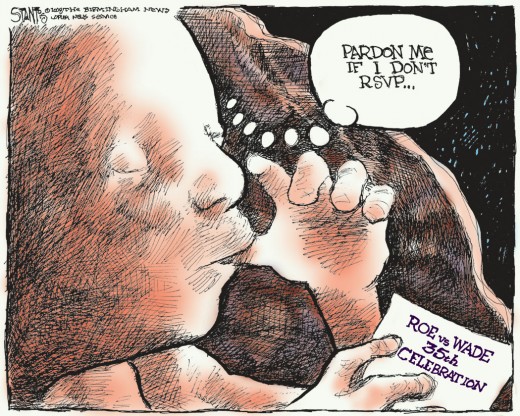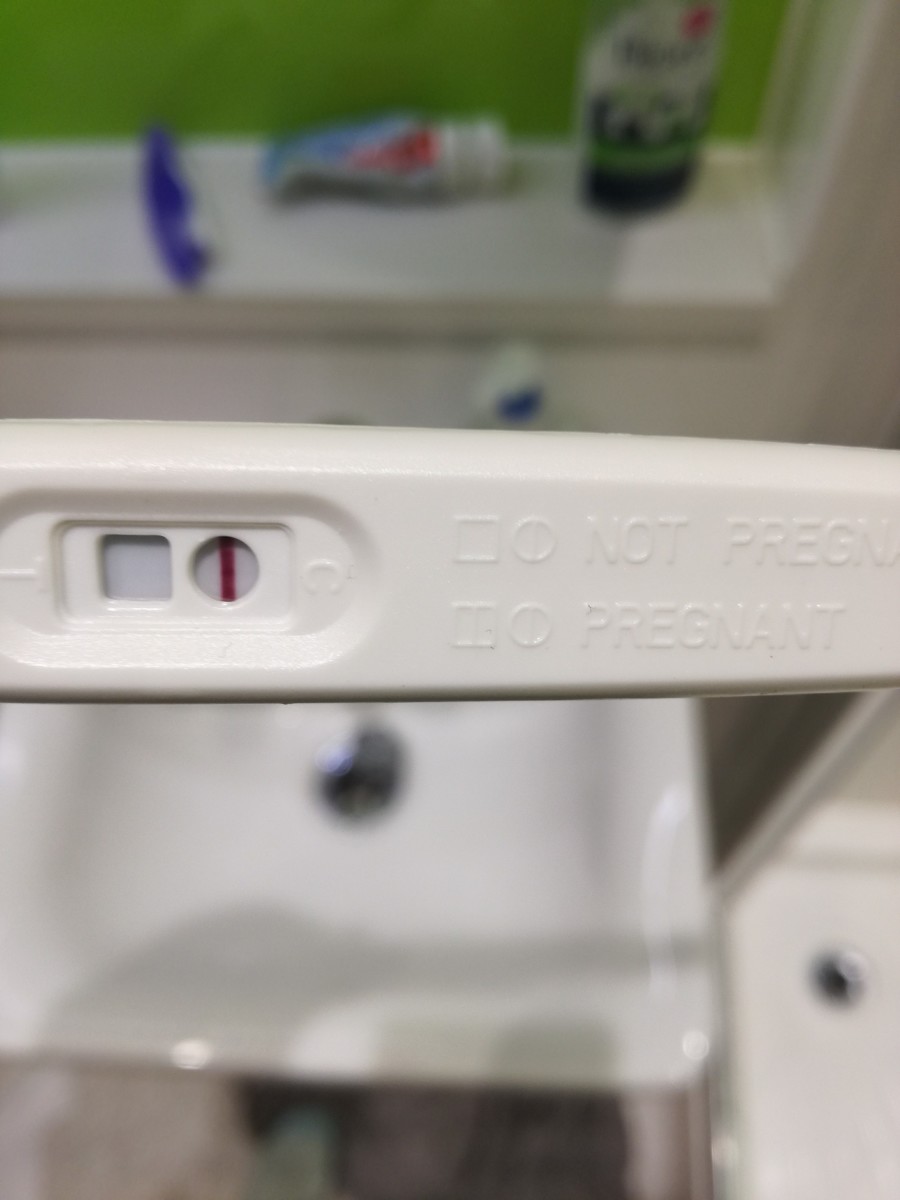“Since the Roe v. Wade case in 1973, over 47 million babies have been legally aborted.”

Before Reading...
Which do you support?
The Position
A young girl, barely nineteen, enters the anxious atmosphere of her local Planned Parenthood. She has heard stories of the place, but has never visited it herself. The nurse asks her why she is there and somehow she hears her voice squeak out that she is there for an abortion. She cannot believe that those words just came out of her mouth, an abortion! The nurse gives her paperwork to fill out and starts to help the next girl in line. This girl, however, is at least twenty-five years old and says she is here for another abortion, very nonchalantly, of course. After a wait that seemed like days, she is called into the back of the clinic. She gets her blood taken and changes into a hospital gown; now she only has to wait until her name is called.
Sitting there she looks back on what happened two and a half months ago that brought her here. One drunken night at a fraternity she got raped because a guy put Gamma hydroxy butyrate (GHB), also known as the “date rape drug” into her drink. It was hard enough to report, but even harder to realize she was pregnant with an acquaintance’s baby. She never thought this would happen to her. “Jessica Tate*,” the nurse calls. She stands up and enters the room where the procedure will take place. It is small, white, and smells of bleach. The nurse instructs Jessica to get herself settled on the table. Since she opted to stay awake for the abortion, she must stay completely still throughout the whole procedure. She feels a stabbing sensation in her lower abdomen and tries her best not to flinch or move. She tries to prevent tears from running down her cheeks, but it becomes unbearable once she hears a vacuum sound, the vacuum sound that is sucking her unwanted baby out of her, limb by limb.
What took fifteen minutes to create, took about seven minutes to destroy. After waiting about thirty minutes, Jessica was released to leave Planned Parenthood. Upon getting in the car, she just broke down. It was over. She had just ended her child’s life (Tate).
So the main question is why should the public care about Jessica and her experience at Planned Parenthood? It is on the public agenda because rather than obtain an abortion because of sexual assault, the vast majority of abortions occur because of lack of personal and sexual responsibility. In 2005 alone, less than 2% of all abortions were performed as the result of rape (United States Abortion Statistics). The general public is affected by this statistic because it concerns future generations, populations, and perhaps even future leaders, prodigies, or geniuses. In this document, one may find information on the definitions of “abortion” and “rape,” why the case of Roe v. Wade had, and continues to have, such an impact on the United States. Also featured are reasons why women have obtained abortions and the likelihood of becoming pregnant from rape.
Medically, “abortion” is referred to as “the premature expulsion from the uterus of the products of conception of the embryo or of a nonviable foetus” (“Abortion” On-line Medical Dictionary). According to FindLaw.com, an online legal dictionary, “abortion” is defined as “the termination of a pregnancy after, accompanied by, or closely followed by the death of the embryo or fetus” (“Abortion” FindLaw). These two definitions are similar; the medical term is more in depth, while the legal definition is simply a straightforward description. Though “abortion” is technically a medical term, the legal definition is the one that is considered in cases such as Roe v. Wade.
“Rape,” according to The ‘Lectric Law Library’s Legal Lexicon, is “the carnal knowledge of a woman by a man (or vice versa) forcibly and unlawfully against her will” (“Rape” Legal Definition of Rape). Similar to the legal definition, a medical definition of “rape” is “unlawful sexual activity and usually sexual intercourse carried out forcibly or under threat of injury against the will usually of a female or with a person who is beneath a certain age or incapable of valid consent” (“Rape” MedlinePlus: Medical Dictionary). Unlike with “abortion,” both versions of the definition of “rape” are essential when it comes to the idea and/or report of rape.
Roe v. Wade was a significant case in the United States because it legalized abortion, a long-standing controversial issue. In a direct quotation from the case, “State criminal abortion laws, like those involved here, that except from criminality…violate the Due Process Clause of the Fourteenth Amendment, which protects against state action the right to privacy, including a woman's qualified right to terminate her pregnancy” (Roe v. Wade). On September 17, 2003, Senator Dianne Feinstein addressed the President and summarized Roe v. Wade as, “In 1973, in Roe v. Wade, the Supreme Court decided that a woman's constitutional right to privacy includes her qualified right to terminate her pregnancy” (Feinstein). Since this decision was made, the lives of over 47 million living human beings have been terminated by their mothers for a number of reasons in the past thirty-three years (47 Million abortions in U.S. since 1973). That means that only 1% of these 47 million deaths were the result of rape (“Share the Truth About Your Unexpected Pregnancy”). Not only did Roe v. Wade allow for women to obtain legal abortions, but it was also a step towards lowering the amount of oppression of womankind. Women felt empowered to be able to decide what to do with their own bodies (Human Rights Watch: Women’s Human Rights).
Since the case of Roe v. Wade, the number of women getting abortions has fluctuated, from a low in 1973 at approximately 750,000 to a high in 1990 at approximately 1,600,000 (United States Abortion Statistics). According to the Rape, Abuse, & Incest National Network, in 2005 there were about 1,300,000 abortions. Of those 1,300,000 abortions, only 26,000 were a result of rape cases. It can be assumed, however, that these statistics may not be completely accurate because approximately 59% of rapes are not even reported (Statistics). So how come there have been so many abortions but very few of those have been the result of rape?
A possible theory is that there is a higher percentage of abortions due to rape, however, they are just not reported. It has been shown that 95% of all abortions have been done as a method of birth control. Wanting to postpone childbearing makes up for 25.5% of that 95%, while not being able to afford a baby comes in second at 21.3%. Other reasons to abort that make up this “birth control” majority is not wanting any (more) children, not wanting to disrupt one’s education or job, having a relationship problem or a partner who does not want a pregnancy, being too young, and risking one’s health. What are called “hard reasons” make the 5% category in which rape is included. Rape and incest make up 1%, while another 1% is due to fetal abnormalities and 3% to the mother’s health issues (“Abortion Statistics”). From this information, one can conclude that the majority of abortions are due to a lack of responsibility rather than criminal sexual activities.
To help bring this rape/pregnancy concept into a clearer perspective, a look at the rape statistics for 2005 will provide a better representation. For that year, there were 64,080 women who were raped. “According to medical reports, the incidence of pregnancy for one-time unprotected sexual intercourse is 5%.” If you apply this rate to the number of rapes in 2005, it is approximated that there were as many as 3,204 pregnancies as a result of rape instances for that year. As far as the possibility of getting raped in general, one in every six women is a victim (“Pregnancies Resulting from Rape”). So when all these statistics are put into perspective, one can understand how very low the chances are of, first, getting raped, then becoming pregnant by it, and lastly, to get an abortion as a result. For all three of these actions to occur, it is about a 0.02% chance. Unfortunately there are people in the United States who have to experience this very small percentage, those like Jessica Tate.
One might then consider why abortion rates are so high and yet the percentage of abortions resulting from rape is so low. Some people may be pro-life and may not agree with abortion no matter what the situation may be. Others may not want to experience further trauma. As to why 98% of abortions are not the result of rape, it can be assumed that others feel abortion is merely a right of passage or is not to be given much thought. Perhaps some people may not even realize the intensity of the issue. Either way, the amount of abortions as the result of rape is extremely low in proportion to its counterparts.
Indeed, a small percentage of all abortions are the result of rape cases. Since Roe v. Wade was established in 1973, women have been given the choice to decide to keep or end their pregnancies. While this right has been exercised in rough circumstances such as rape, a majority of abortions stem from the lack of sexual responsibility. As previously stated, in 2005 only 2% of all abortions that occurred were the result of rape. Since 1973, only 1% of all legal abortions were attributed to instances of rape. The proposition in this document is significant because it demonstrates that Roe v. Wade seems to have been established so that irresponsible people may obtain abortions and terminate life. The 0.02% chance of getting raped, impregnated, and aborted happened to Jessica Tate; a young girl who had to endure a misfortune and just turned into another statistic. This issue is reality and it is happening in the United States – abortion is acting as a mistake-fixer rather than as an aid to rape victims.
Sources
“47 Million abortions in U.S. since 1973. The Anointing. 8 Feb. 2007.
<http://www.annointed.net/Article976.html>.
“Abortion.” FindLaw. 8 Feb. 2007.
<http://dictionary.lp.findlaw.com/scripts/results.pl?co=dictionary.lp.findlaw.com&topic=80/804a02d360f0b38138851e2548dc6c66>.
“Abortion.” On-line Medical Dictionary. 8 Feb. 2007. <http://cancerweb.ncl.ac.uk/cgi-
bin/omd?abortion>.
Abortion Facts and Statistics. Justice For All: Students For Life. 8 Feb. 2007.
<http://jfa.org.ohio-state.edu/Facts.htm>.
“Abortion Statistics.” Abortion: Tune into the Truth TV. 10 Feb. 2007.
<http://www.abortiontv.com/Misc/AbortionStatistics.htm#Why%20Abortions%2
0Are%20Performed>.
Feinstein, Dianne. The Importance of Roe v. Wade. Congressional Record. 8 Feb. 2007.
<http://feinstein.senate.gov/03Speeches/pba_state_crformat.htm>.
Human Rights Watch: Women’s Human Rights. Human Rights Watch. 10 Feb. 2007.
<http://hrw.org/women/abortion/us.html>.
“Pregnancies Resulting from Rape.” Rape, Abuse, & Incest National Network. 10 Feb.
2007. <http://www.rainn.org/statistics/pregnancies.html?PHPSESSID= cffad0fc6dc4223d2c6e761acd27caec>.
“Rape.” Legal Definition of Rape. The ‘Lectric Law Library’s Legal Lexicon. 9 Feb.
2007. <http://www.lectlaw.com/def2/q097.htm>.
“Rape.” MedlinePlus: Medical Dictionary. 9 Feb. 2007. < http://www2.merriam-
webster.com/cgi-bin/mwmednlm>.
Roe v. Wade. Abortion Law Homepage. 9 Feb. 2007.
<http://hometown.aol.com/abtrbng/410us113.htm>.
“Share the Truth About Your Unexpected Pregnancy.” Stand Up Girl. 9 Feb. 2007.
<http://standupgirl.com/web/index.php?option=com_content&task=blogcategory
&id=86&Itemid=80>.
Statistics. Rape, Abuse, & Incest National Network. 9 Feb. 2007.
<http://www.rainn.org/statistics/index.html>.
Tate, Jessica*. Personal interview. 2 Feb. 2007.
United States Abortion Statistics. Minnesota Concerned Citizens for Life. 8 Feb. 2007.
<http://www.mccl.org/abortion_statistics.htm>.








